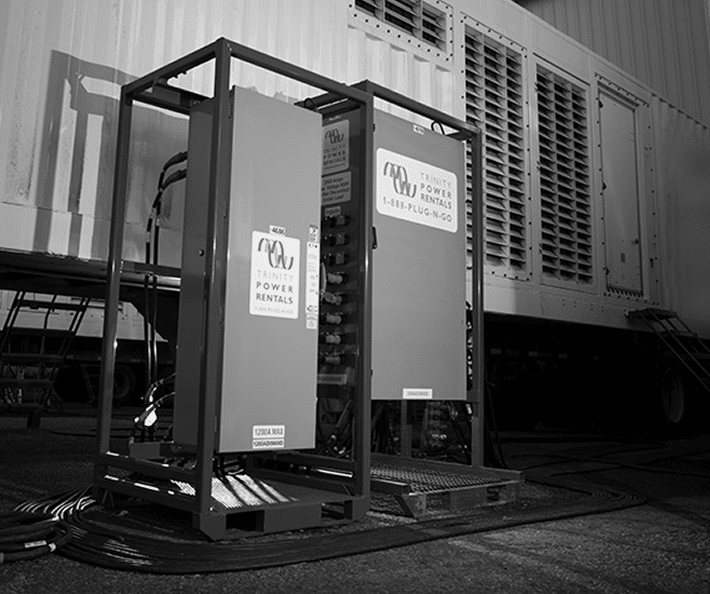- OUR APPROACH
-
COMMITTED TO YOUR SUCCESS
Our approach, developed over decades of experience, is fine-tuned to get the results you want.
We deliver concept-to-completion solutions, designed by temporary power specialists with access to the largest inventory of high-quality power generation and distribution equipment in North America.
-
- Equipment
-
RENTALS
From a wide range of diesel and natural gas generators to transformers, cable, light towers and more, our large rental fleet and extensive vendor network ensure we’ll have the temporary power equipment that your project requires — every time.

-
- Industries
-
INDUSTRIES WE SERVE
For nearly 20 years, we have been at work powering projects across Canada’s industrial sectors.
Select from this sampling of industries to learn how we can put our expertise to work for you.
VIEW ALL- Projects
- About
-
A PROUD HISTORY. A BRIGHT FUTURE.
From our inception in 1998, we have been building our team on a foundation of excellence. Our team members’ passion, expertise and commitment are what have allowed us to grow into a national company with projects across Canada.
Click on the links to learn more about our history, our team or our career opportunities.
- Blog
- Contact
-
From Pipelines to LNG, hydro to nuclear, the Major Projects Management Office (MPMO) is involved in every resource project in Canada that requires a federal environmental assessment. But what is the MPMO, and what do they do? And how, exactly, will they be affected by the new Liberal Government’s plan to make the assessment process more “robust”?
Reporting to the Minister of Natural Resources, the relatively small federal government organization was established in 2007, with a mandate to, “Improve the federal regulatory system so as to have an efficient process, capable of reaching decisions on major resource projects in a more timely and effective manner, while ensuring careful consideration of environmental standards, Aboriginal consultation obligations and technical requirements.”
In practice, the MPMO operates as a single point of contact for projects that are navigating the winding pathways of federal environmental assessment and regulatory permitting, required for any major resource project in Canada to proceed.
This means that companies can come to the MPMO before they submit a project description that would set an environmental assessment in motion, and have their questions about the process answered.
Whether or not a company approaches the office, though, the MPMO will be involved in the environmental assessment and permitting process. When a company approaches the environmental assessment agency, or another department, with a project description, the MPMO becomes involved right away, facilitating collaboration between the various federal departments that will be involved in the regulatory process for the project.
Out of this collaboration, the MPMO then creates a Project Agreement, outlining the roles and responsibilities within the federal government, and setting out timelines for the various stages of the process. Once the project agreement is complete, deputy ministers sign it, and the MPMO puts it up on their website. Making the Project Agreements public in this way ensures that the process is transparent, and holds the government accountable to the various stakeholders in the project; companies, first nations and other interested parties can see exactly how the regulatory review is going to unfold.
With the Project Agreement signed and made public, and the regulatory review underway, the MPMO shifts into monitoring mode: tracking the review’s progress, and watching for any issues that might arise. If and when there are issues, the MPMO’s job is to resolve them, to keep things on track, and to ensure that the review is both efficient and effective.
The MPMO does a lot of things, but there are a few things it doesn’t do; the office’s role is, first and foremost, to coordinate between federal departments. It does not play a part in the decision-making aspect of the review process, leaving the environmental assessment and regulatory permitting entirely in the hands of the relevant departments.
With the new Liberal Government in charge, and James Carr newly at the helm of the Ministry of Natural Resources, however, this process, and the MPMO’s role in it, may change.
Prime Minister Trudeau’s mandate letter to Carr emphasizes a focus on clean energy and a commitment to restoring the public’s faith in the environmental review process. Carr has said that there will be a transition to an amended project evaluation process but has not given any details as to what or when that might be.
In a talk he gave recently at an International Energy Agency meeting in Paris, Carr said that the ministry will find a “sweet spot” between addressing the concerns of oil and gas stakeholders and furthering the Liberal environmental mandate.
For everything that’s been said so far, it’s still very early in the game, and nobody at the MPMO, or at any other agency, is quite sure how the mandate will affect oil and gas, and other natural resource sectors.
But for now, Carr says that it will be business as usual for projects currently undergoing an environmental and regulatory permitting review.
Related Articles
Subscribe for Access to Exclusive Content
Get insider updates, industry news, special equipment offers, and expert tips—directly to your inbox.
"*" indicates required fields




















